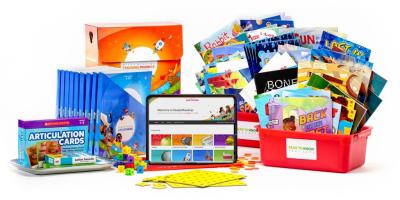Evaluation for 5.E.1d
Materials provide a variety of activities and/or resources to support students in decoding and encoding words that include taught sound-spelling patterns, both in isolation (e.g., word lists) and in decodable connected text that builds on previous instruction (e.g., within sentences or decodable texts). (PR 2.A.1 & 2.A.3) (S)
The "Short Reads Decodables" provides a variety of activities to support students in decoding words that include taught sound-spelling patterns, both in isolation and decodable connected text that builds on previous instruction. For example, the "This Bird" lesson provides guidance for reviewing the recently introduced sound-spellings of /d/, /r/, /i/, and /h/. Then, students practice reading decodable words in isolation (e.g., rap, it, and hid) before moving into the decodable text that includes the same words and sound-spelling patterns. The Wiley Blevins Teaching Phonics lessons provide a variety of activities to support students in encoding words that include taught sound-spelling patterns, both in isolation and in decodable connected sentences that builds on previous instruction. For example, Step 4 of the lesson s-Blends provides guidance to use the "Spell Words: s-Blends" activity for students to practice spelling words with s-blends in isolation and a connected sentence: "Use the digital or print 'Spell Words: s-Blends' activity to give children practice spelling the letter-sounds in different picture names. (Answers: s-t-o-p, s-l-e-d, s-w-i-m, s-p-i-ll, s-m-e-ll) On a separate sheet of paper, have them spell the following words as you dictate each one: snap, spot, skin, slip, stick. Continue by dictating this sentence: The dog has a black spot. Display the words and sentence, and have children self-correct their answers." Additionally, the lesson provides additional sentences to dictate that include previously taught phonics skills, such as "We had fun in the snow" and "Do not step on the wet spot." The "Read to Know Text Sets" provides a variety of activities to support students in decoding words that include taught sound-spelling patterns in decodable connected text that builds on previous instruction. For example, "Text Set 1: Two BIG Cats Instructional Options" includes guidance for playing the game "What's the Sound?" to support the targeted sound-spelling patterns: "Play a game in which children identify short vowel sounds in words with a consonant-vowel-consonant (CVC) pattern. Model: Say: Listen. When I say a word, please repeat it and then say its vowel sound, /a/, /i/, or /o/. For example, if I said 'cat,' you would say 'cat,' /a/. Play: Use these words, segmenting sounds as needed, and write or have children write the words after each turn: peg, top, pack, nap, fit, did, dot, rock."



